Hair Transplant Scar Repair and Scar Revision Dr Sean Behnam
Table Of Content

It is imperative to work with a clinic and a staff that puts your health and the success of your hair restoration before anything else, like UnitedCare. Clinics that practice FUT or more traditional variations of FUE usually have inexperienced physicians onboard and a desire to cut costs. The last type of scars, and frankly your best option, is the millimetric round scars caused by FUE surgeries. There was no way around these punch-hole scars, and the only way to hide them was to have long hair to cover them up.
Post-operative care
But keep in mind that post hair transplant care of both your donor and recipient area is important for quick and efficient healing of scars. As you consider getting a hair transplant to restore your hairline and get your natural look back, you’ll notice many people mention scars caused by the surgery as a huge disadvantage. ➡ The scars naturally caused during your surgery are minimal and, with healing, will fade over time. However, whether you have larger and permanent scars depends on which surgery technique you choose.
Minimizing Scars from a Hair Transplant for the Natural Look
These scars are most often covered with SMP or TMP, which recreates the follicles using tattooed micropigmentation. This could be the best option if you have significant discoloration around your car. These can reduce significant scars and may be used in combination with SMP or TMP to completely hide the scar.
Hair Transplants and Treatment
So even though it might end up being more of a bald area than a complete scar, it’ll still look very unnatural and noticeable. The first issue is, that it will leave a scar that will fade away only to a certain degree because there was a huge cut at this site. Now, at the site where this donor tissue is cut, things won’t be looking good for, well, ever. It consisted of extracting 4mm-wide tissue from your donor area to directly implant into your balding areas in a series of sessions (usually 4). Scars usually look paler than the surrounding tissue, and in most cases, they will fade away over time to be less and less noticeable. In this blog, I’ll shed light on one of the most discussed topics when it comes to hair restoration, so bear with me.

As a wider part of the medical tourism initiative, the government funds much of the process — taking on a large percentage of machinery, employee salaries, and VAT discount support. This is one of the most convenient and economical ways to address hair loss. According to Dr. Doshi, hair transplants cost between $10K to $50K by top surgeons in the United States, in comparison to the $3,000 charged in Istanbul.
FUT or FUE: Which Has Worse Scarring?
Talk to a doctor about what type of hair transplant may work best for your scar tissue, and what to expect during and after the procedure. Hair follicles are capsules underneath the skin that hold and regrow hair. But when a scar forms on damaged skin, hair follicles don’t grow back. This is because scars are made of thick fibrous tissue called collagen that forms to protect the skin underneath. Turkish doctors are known for their innovations in the field of hair transplantation. Every hair transplant operation is performed after a thorough hair analysis and using the most suitable method with the maximum number of grafts if necessary.
How Did Joe Rogan Get That Head Scar? Here's the Surprising Story - Distractify
How Did Joe Rogan Get That Head Scar? Here's the Surprising Story.
Posted: Thu, 29 Apr 2021 07:00:00 GMT [source]
Some Examples Of Undetectable Hair Transplant Scars by Hasson & Wong
Many companies claim that FUE techniques are scarless, however, they still do cause a series of tiny scars from the removal of individual follicles. A 2016 study surveyed people who had undergone FUE hair transplant surgery about 3 years later. The average satisfaction rating of the participants was 8.3 out of 10. A hair transplant typically costs between $4,000 and $15,000, varying depending on the procedure and clinic.

Once the hair strip has been removed, the area is sutured together. The procedure may also be repeated several times over the course of two or three months to achieve the best result. Whichever you choose, know that wound-closure techniques have improved, along with the procedures themselves.
For most hair transplant patients, scars from FUT strip surgery are a reasonable tradeoff they’re happy to make to gain their healthy scalp hair back once again. While the incisions on the donor area can range in size, they are generally relatively wide and long, especially if the surgeon requires a lot of hair for transplantation to the scalp. Once the desired amount of tissue is removed, the surgeon will then close up the wound on the back of the head with stitches and proceed to the grafting process. There are procedures available to lessen or reduce the appearance of a scar left after the FUT hair transplant. These procedures are not able to completely remove the scar, however, as some of the damaged tissue is impossible to completely remove.
Finally, while some small scars result from FUE, they are typically much smaller and spread throughout a broader donor region. The hair that ends up on the recipient area is, for the most part, just as reliable and healthy, with minimal transection. Laser treatment therapy is another form of treatment for scarring, and it is often used along with SMP or TMP for the greatest results.
This also means your surgeon will choose the best method of hair transplantation for you. This will prevent any further complications and you will likely be left with minimal scarring. A hair transplant is a good option for people who can afford the high cost of the procedure and haven’t found success from treatments like minoxidil or Rogaine. Hair transplant surgery is relatively low risk compared with other surgeries, but it isn’t without risks. There is also always the possibility that your hair regrowth may be minimal.
These treatments work by stimulating collagen production and remodeling the scar tissue, making it blend more seamlessly with the surrounding healthy skin. Laser options vary, and Dr. Bared can recommend the most suitable one based on the scar’s characteristics. But, if you go along with a more advanced FUE variation, your scars will drop to a very small size that will be hardly visible to the naked eye, in which benefits should outweigh the risks. Finally, many hair transplant patients opt for a procedure called scalp micropigmentation after they are completely healed.
In cases where hair transplant scars are more prominent than desired, scar revision surgery can be an option. This procedure, performed by experienced surgeons like Dr. Bared, involves removing the scar tissue and re-closing the wound with advanced techniques aimed at producing a less noticeable scar. The preferred method to conceal scars from an FUT hair transplant is to use an FUE hair transplant technique to cover the scar. Keloid scars, for instance, are a form of raised scarring which grow beyond the width of the surgical scar originally left behind from the cosmetic procedure. This form of scarring is difficult to transplant hair onto as the grafts cannot access the blood supply from the scalp which is necessary for their future growth. Regardless of which surgeon or country you decide to get a hair transplant in, make sure that the process starts with a consultation.
Comments
Post a Comment